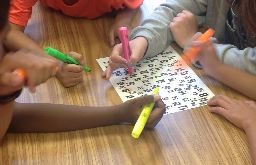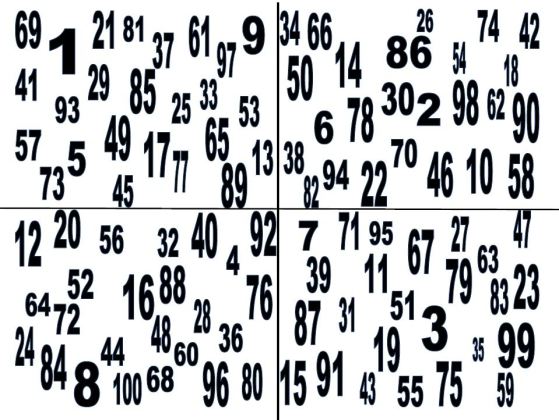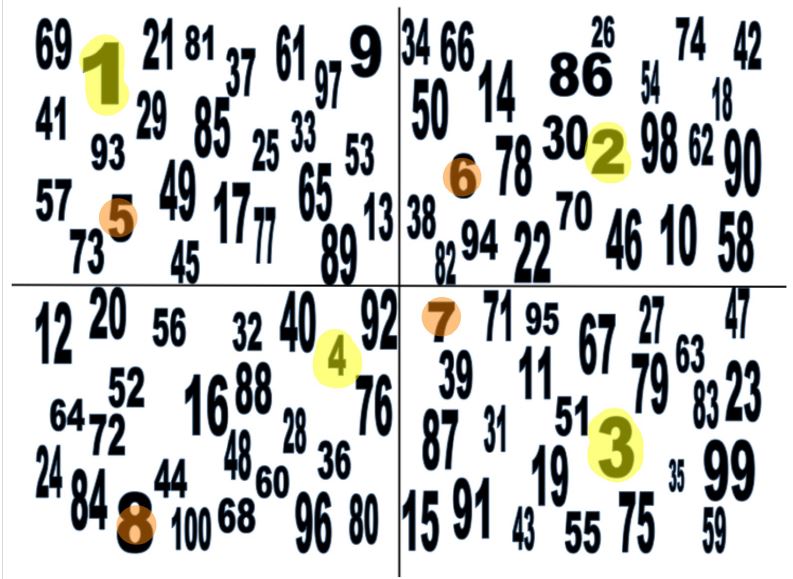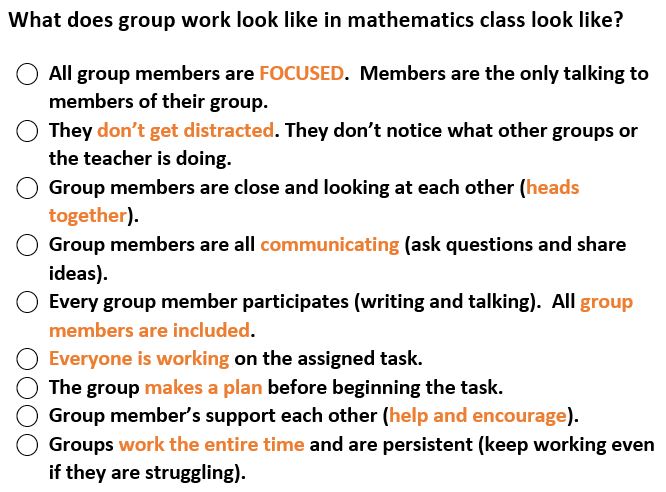100 Numbers to Get Students Talking
New UPDATE – October 2022 – with new 100 Numbers form at end of post (scroll down)
UPDATE AUGUST 2020: Is it possible to do the 100 Number Task in Distance Learning? I have a new post answering this question. Check it out HERE
UPDATE May 2020 – Several super creative educators are re-imagining this activity for the COVID-19 era. Scroll to the bottom for links to their ideas.
UPDATE! (8.17.17) There are 3 new versions of this activity – scroll to the bottom for links/downloads.
I have 5-10 things that other math teachers ask me for again and again. (eventually I’ll blog about all of them). The item in this blog is one of them. This one is different though because I also get tons and tons of feedback on how useful it is.
My friend Megan Schmidt (@veganmathbeagle) blogged this week about Making Groups Work using a task she got from me. She encouraged me to blog about the same task she did. The following post will have some similarities to Megans with a few additions. Make sure to read her post. ONE SIDE NOTE: MARILYN BURNS (math goddess) commented on her post on this activity, so this activity must have something you may want to look at – just sayin.
January 2017 update: Thom Gibson recently made a video about him using this task with his students. Check it out here and read further for my take on this task.
My goal:
A quote that has longed haunted me from a presentation I saw several years ago is ‘He/she who does the most talking does the most learning’. I had heard versions of this before, but 10 years ago I decided to get serious about changing the percentage of time I talk in class and increase the percent of time EVERY student in my class was talking. I changed lots of things. This post is about just one tweak I made. The results of all these tweaks was a noticeable increase in the time EVERY student in my class talked about math out loud. My goal is to get all students talking – about math – every day.
A TASK to get every group to look like this Day 3 of school.
If I am going to get students to talk every day of class, then I need to teach them how to work in groups and teach them how to talk to one another. This is my goal week one of school. Lots of years ago, Beth Esposito gave me this task (I think it is an AVID task) that I’ve adapted. It is magic. It makes groups look like the pics above with little effort on my part. I’ve used this activity in both middle and high school and it works great at both levels. Here is the task. I call it the 100# task.
Implementing the task:
- Group students any way you like (my groups week one are alphabetical). Groups of 4 work best for this task. Groups of 3 and 5 work too.
- This task takes a minimum of 25 minutes and can last up to a 55 minute class period depending on how you implement the task. I spend longer with middle school students and it seems to go more quickly with HS students. I’ve done this task on the 3rd day of school the last several years.
- You will need one highlighter per student and 3 copies per group of the first page of this task. 1-100_group_work_activity (Note: This document is a set of directions I attached to my districts curriculum guides that has some of the information written below 1-100 Task Directions or Teachers
- Tell your students that in this class they will be expected to talk about math out loud everyday. Many days they will be talking and working with either a partner or their group. Today we are going to practice what it is like to work in groups.
- Give directions for the task. I show the task on my Smart Board for 1 minute and turn it off. I then say their group will have 3 minutes to find as many numbers from 1-100 in order.
 Group members will take turns going in a circle highlighting each number as they find it. Student 1 will highlight 1, student 2 highlights 2, student 3 highlights 3….when we get back to student 1, they highlight the next number. They can help each other find numbers, but each student has to highlight their number in turn.
Group members will take turns going in a circle highlighting each number as they find it. Student 1 will highlight 1, student 2 highlights 2, student 3 highlights 3….when we get back to student 1, they highlight the next number. They can help each other find numbers, but each student has to highlight their number in turn. - Ask students to clear their tables of everything
 . Hand out one highlighter per student. Hand out one copy of the numbers 1-100 to each group UPSIDE DOWN.
. Hand out one highlighter per student. Hand out one copy of the numbers 1-100 to each group UPSIDE DOWN. - Put a 3 minute timer up front. (note to teachers, groups generally find 20-40 numbers the first time they do this activity). Say go. While students are working, GET OUT YOUR PHONE and start taking pictures of the groups as they work. I take pics of every group in round 1 and 2 of this activity.
- At 3 minutes, say ‘hands up’. Ask groups how many numbers they found. Tell them we will be doing this activity again. Have students talk with their group about a strategy to do better the next time. Give groups 2-5 minutes to talk. Have a few groups share out what went well in round 1.
- This is where you have some choice. You need to do this 3 minute activity at least twice, but can do it 3 or 4 times. I do the 3 min round twice with HS students and 3 times with MS students.
- If you only do this twice, then ask students to also talk about any patterns they noticed in the numbers. Tell them there is a pattern to
 the numbers. (On day 2 I gave them the definition of math-the study of patterns and we talked about how recognizing patterns can make us more efficient) Ask students to share out what they noticed. I do this on the smart board. I’ve always had at least one group in every class that noticed that the first number was in the top left quadrant and the 2nd number was in the upper right quadrant as shown below (and I show this to everyone on the smart board after a group names it). If you are doing the 3 min round 3 times, wait to talk about patterns until between rounds 2 and 3.
the numbers. (On day 2 I gave them the definition of math-the study of patterns and we talked about how recognizing patterns can make us more efficient) Ask students to share out what they noticed. I do this on the smart board. I’ve always had at least one group in every class that noticed that the first number was in the top left quadrant and the 2nd number was in the upper right quadrant as shown below (and I show this to everyone on the smart board after a group names it). If you are doing the 3 min round 3 times, wait to talk about patterns until between rounds 2 and 3.
- In round 2 (and 3) tell students that their goal is to get more than round 1. (Note, I love how Megan implemented this part and recorded their results in round 1 and 2 and calculated the % increase. I’ve not done it that way yet, but I will). Set the timer for 3 minutes. Say go and TAKE PHOTOS again.
- At 3 minutes day ‘hands up’. Collect the results. I’ve always had EVERY single group’s result go up.
- Next show students the photos you took while they are working in groups. When I do this, almost every student says ‘I did not even know you took our photo’. I then ask why do you think this was? They say they were so focused on the task that they did not
notice what was going on around them. I say, this is what I want group work to look like EVERY time we do group work in my class.
- I have every student get out their notebook and do a individual quick write on the question “What does great group work in math look like?” Students share their ideas with their groups and groups share out ideas with the class as I record their ideas.
- The next day I come to class with a consolidated list of what group work looks like in Ms. Van’s classroom. I tell them this is the rubric we will use all year. Here is a copy of what my 2015-2016 students came up with.

- The next day it is imperative that you have a group task for students to work on in class so they can practice working in groups using the rubric they developed.

- Here are the tasks I’ve used the last couple of years. You want to choose a task that has multiple entry points for all level of students. Something they will struggle with a bit, but not too much. Something that is emotionally safe for the class since we are just getting to know one another. Since I use this the first week of school I select tasks that should be review of material they’ve learned in the past (but may have forgotten). Here are my favorite tasks to use for this:
- In grade 7 I used Dan Meyer’s Partial Product Task. Students should enter 7th grade with an understanding of ratios, and this is a great task for week 1.

- In grade 8 I used the In & Out 100×100 task from Robert Kaplinsky’s site.

- This year in AdvAlgebra I used Fawn Nguyens Noah’s Ark task. This task would work well at most grade levels. Noahs-Ark

- UPDATE 9.14.18: I get asked all the time for other tasks to use with students. If you have one, please share what you use. One recent person emailed asking about tasks for 5th grade. My good friend, Laura Wagenman, responded that she loves using Jo Boaler’s Four 4’s as a first task after the 100 #’s group modeling task. She shared all of her upper elementary beginning of the year stuff HERE. (thanks Laura).
- In grade 7 I used Dan Meyer’s Partial Product Task. Students should enter 7th grade with an understanding of ratios, and this is a great task for week 1.
- After spending time working with partners on the task, give students some type of exit ticket to reflect on their group work for the day. Here is one I used.

- I recommend printing out and posting the pictures you took of groups working. Every time you do group work, point to the pictures and say ‘Today we are doing a group task, what do I expect your group to look/sound/feel like today?’
- You can use this task mid year too. If you do, I recommend using it at the start of a quarter or semester.
That’s it. The 25 minutes I spend on this task at the start of the year pays off big time I do group or partner work. Students know what group work should look like, as a result more students talk in class. I have more tricks up my sleeve to get students talking, but this is one of the first I do each school year.
UPDATE! (8.17.17) There are 3 new versions of this activity!
 Greta Bergman made a version 2 of this activity to use with students who had seen my original one above. It includes expressions and a new pattern. Check it out on her blog HERE for more information and to download the pdf.
Greta Bergman made a version 2 of this activity to use with students who had seen my original one above. It includes expressions and a new pattern. Check it out on her blog HERE for more information and to download the pdf.
 Tony Riehl made a version for groups of 3. Download his version HERE: 100s chart for groups of 3
Tony Riehl made a version for groups of 3. Download his version HERE: 100s chart for groups of 3
I teach HS and have shared the original task with many, many in my district. I too want to try something new this fall. Here is what I came up with for my Advanced Algebra (Alg 2) classes. I am a bit concerned using expressions made up of factors vs. just numbers as it takes away from the week 1 safety of the original task. I am a bit fearful of students shutting down if they don’t define themselves as being quick with math facts. I plan to define a few terms prior by printing this on the pack of their task sheet (I always pass out the 100#’s upside down). 
I then plan to have them flip the sheet to the 100# expressions side and let them all silently look at it for 30-60 seconds before we begin to give them some time to look for their first few numbers. 
There are a couple of things to notice on this version. Every expression is some factored form (some using exponents) of the numbers 1 to 100. You will notice the prime numbers are written as ’11’ vs ’11×1′. I plan to ask questions later about what they notice about the placement of numbers. 
I switched up the starting quadrant (quadrant 4) and the direction (counter-clockwise) compared to the original. I am a bit worried about starting with 10 to the zero power for 1, we will see how this goes. I will be using this the week of August 28th. I’ll update you on how this activity goes.
Here is the Word-doc of my new version with factor/expressions: 100# task FACTORS
Let me know if you find mistakes or have suggestions for improving this task. Have a great start to your school years.
UPDATE 9.14.17
I thought I’d show you how I display the photos I take of my students as they work on the 100# task. I just put this years photos up in my classroom for our Open House tonight. I love to have the photos on my walls so I can refer to them whenever we do a group task and ask “What are 4 things I am looking for all groups to be doing while we work today” as I point at the pictures. (for more on how I hung these up, see my post ‘A peek inside my classroom‘)
I’d love to hear what you think. Email me at [email protected] or Tweet me @saravdwerf or Comment below.
UPDATE January 21, 2019
I get asked often about other activities you can use if you’ve already used the 100 number task. Check out this twitter thread for other ideas…Click the tweet below to see other’s ideas.
UPDATE Spring/Summer 2020
On idea from teachers is to create slides and move this into ZOOM breakout rooms.

UPDATE October 2022 – For everyone that has asked for another version of the 100#’s – Lauren Johnson came to your rescue!
Link to Lauren’s version…. https://docs.google.com/presentation/d/1s6vsVw4nApkNCULr1SPK9ZPPnI8eqYYkH6fsTGFyvbc/edit#slide=id.g16c940c7438_1_34 (organized in diagonal quadrants)


 Group members will take turns going in a circle highlighting each number as they find it. Student 1 will highlight 1, student 2 highlights 2, student 3 highlights 3….when we get back to student 1, they highlight the next number. They can help each other find numbers, but each student has to highlight their number in turn.
Group members will take turns going in a circle highlighting each number as they find it. Student 1 will highlight 1, student 2 highlights 2, student 3 highlights 3….when we get back to student 1, they highlight the next number. They can help each other find numbers, but each student has to highlight their number in turn. . Hand out one highlighter per student. Hand out one copy of the numbers 1-100 to each group UPSIDE DOWN.
. Hand out one highlighter per student. Hand out one copy of the numbers 1-100 to each group UPSIDE DOWN. the numbers. (On day 2 I gave them the definition of math-the study of patterns and we talked about how recognizing patterns can make us more efficient) Ask students to share out what they noticed. I do this on the smart board. I’ve always had at least one group in every class that noticed that the first number was in the top left quadrant and the 2nd number was in the upper right quadrant as shown below (and I show this to everyone on the smart board after a group names it). If you are doing the 3 min round 3 times, wait to talk about patterns until between rounds 2 and 3.
the numbers. (On day 2 I gave them the definition of math-the study of patterns and we talked about how recognizing patterns can make us more efficient) Ask students to share out what they noticed. I do this on the smart board. I’ve always had at least one group in every class that noticed that the first number was in the top left quadrant and the 2nd number was in the upper right quadrant as shown below (and I show this to everyone on the smart board after a group names it). If you are doing the 3 min round 3 times, wait to talk about patterns until between rounds 2 and 3.






